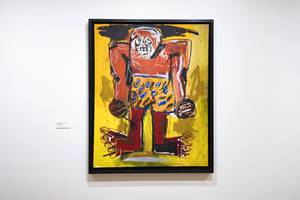Ismael Garcia Santillanes was in dire risk of losing his soul. He had already spent five years in prison and was fading into the empty husk of a prison lifer. Afraid of what he might become, Santillanes joined the Razor Wire Poetry Workshop held at the Northern Nevada Correctional Center in Carson City.
“Poetry’s succinct quality forced me to search deeper into what I truly wanted to express,” Santillanes writes in a forthcoming blog for Nevada Humanities. “The more I wrote, the more I searched, and the more of me I found. It was during that journey of searching for the right word, that I found my own sense of humanity.”
Razor Wire, a powerful new exhibition at Nevada Humanities Program Gallery, features the poetry and visual art of Razor Wire workshop participants. Selected poems and issues of the periodic journal Razor Wire share space with visual art in a variety of styles and mediums, including Santillanes’ large-format pen & ink portraits; intricate scenes in color pencil by Laurence Taaffe; and crisp illustrations by Juan Carlos “Chile” Cervantes.
The poems are honest and deeply personal. They ruminate on themes of forgiveness (“Full of Grace” by Robert Gonzales), nature, the difficulty of love and even the innocent desire to pet a dog after 15 years in prison (“Touch” by Beau Brown). John Fenton’s poem “Iraqi Fugues” hints at an enormous effort to make sense of pain and transform it into art: “Through screams at night,/I lie still, unsure all’s clear,/and I hold my line/with pen or the trigger of other thoughts,/ready to be stained,/ink oozing on the page/from a wound that won’t clot …”
Beloved Nevada author and poet Shaun T. Griffin leads the Razor Wire poetry program and curates the current exhibition. His love and dedication shines from behind the scenes. Santillanes, whose ink portrait of Griffin hangs in the show, writes that for 23 years, Griffin “became my mentor, my father, my brother and my priest.” Santillanes has been free for five years now.
Griffin jokes that he didn’t understand quite what he was getting into when he began volunteering in 1989. He says that he has grown immensely and forged great friendships with workshop members, many of whom are now released. “I’ve watched poetry and painting save lives while inside,” says Griffin, who is working to pilot a similar program in Southern Nevada. “I don’t think it’s the art as much as the access art provides to deeper level of feeling.”
The group meets for 90 minutes in the chapel every other week. Griffin brings literature for members to read and then they give constructive criticism on each other’s work. The process of learning to trust and listen, to share meaningful feedback helps members develop needed life skills. It works. The general recidivism rate is 50 percent, but only two of about 150 Razor Wire members have returned, briefly, to prison. “It’s about holding space for them to rebuild their humanity,” Griffin says. “When you’re inside you have a number and you don’t have an identity; I choose to view them as people.”
RAZOR WIRE Through January 23, Monday-Friday, 1-5 p.m. (until 9 p.m. on Preview Thursday and First Friday). Nevada Humanities Program Gallery, 702-800-4670.







